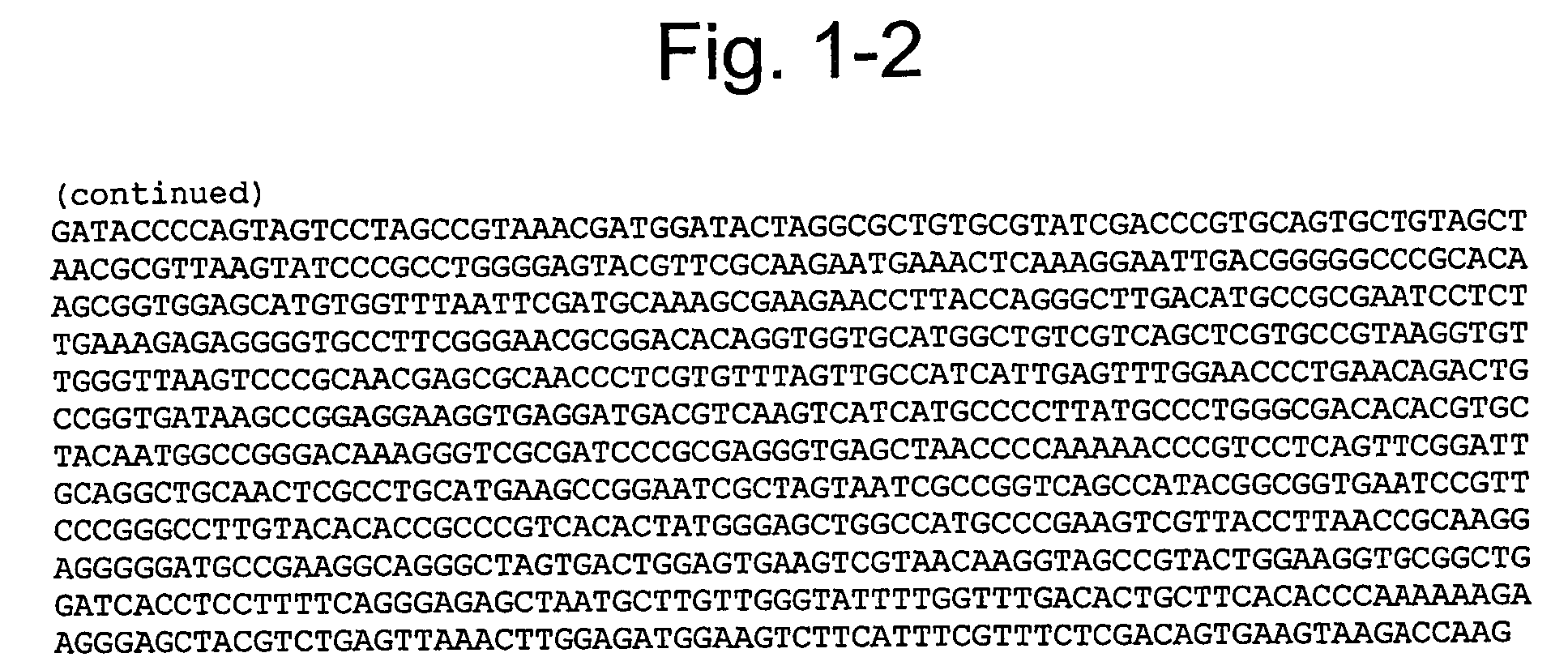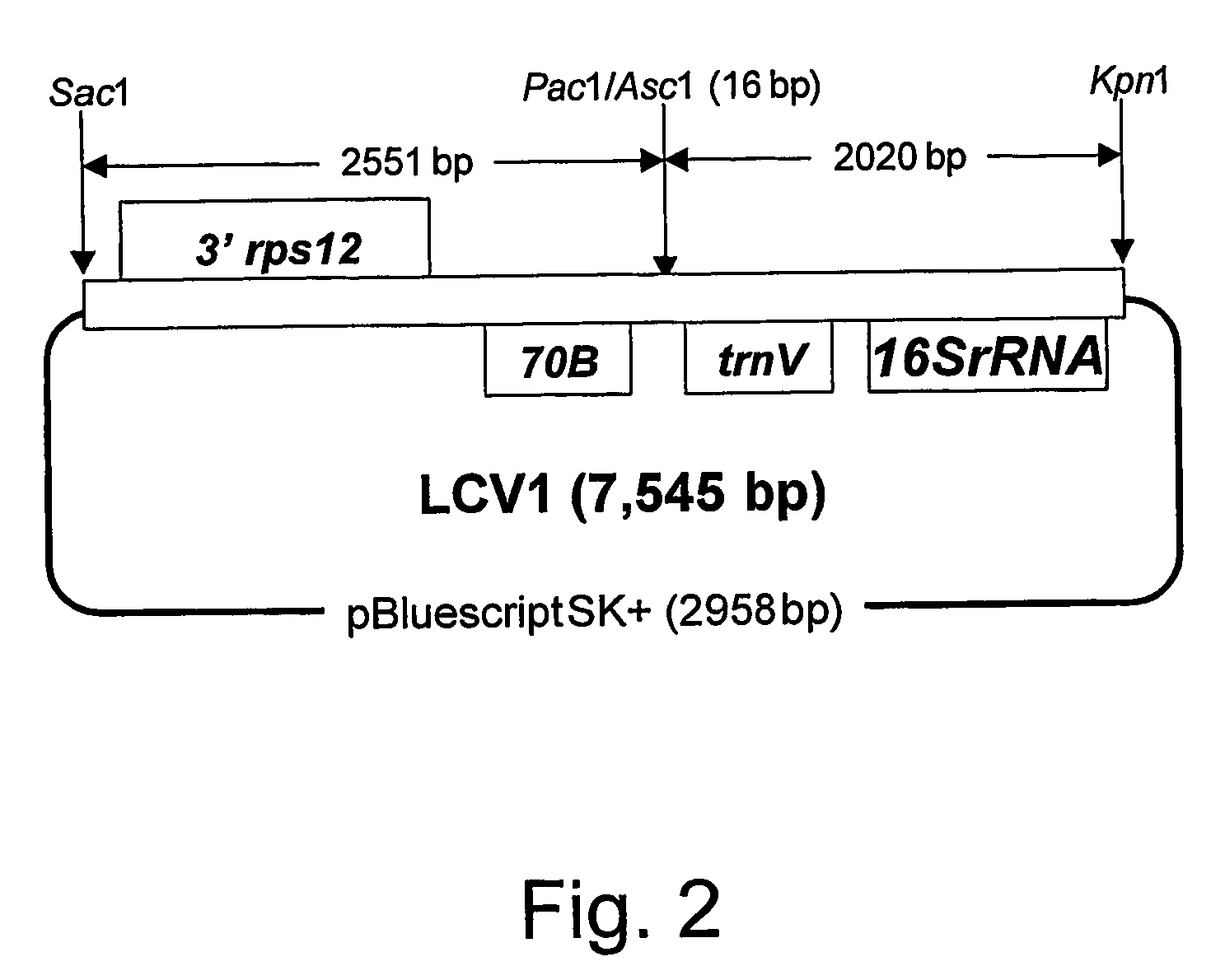Method of plastid transformation in asteraceae, vector for use therein and plants thus obtained
a technology of asteraceae and plastid genome, applied in foreign genetic material cells, virus peptides, plant cells, etc., can solve the problem of high accumulation level of desired protein(s) and achieve the effect of improving the efficiency of transformation
- Summary
- Abstract
- Description
- Claims
- Application Information
AI Technical Summary
Benefits of technology
Problems solved by technology
Method used
Image
Examples
example 1
Vector Constructions
2. Construction of LCV1
[0159]The lettuce chloroplast vector LCV1 consists of 4571 bp of lettuce chloroplast genome sequence with a unique 16 bp Pac1 / Asc1 site added (FIG. 1), cloned into Sac1 / Kpn1 restriction sites on the polylinker of a pBluescript SK+ backbone vector (FIG. 2). The lettuce sequence spans from the rps7 / 3′-rps12 intergenic region to the 16SrRNA / trnI intergenic region and corresponds to nucleotide positions 100021-104387 in the tobacco chloroplast genome (GI accession number Z00044). An alignment of this lettuce sequence with the tobacco chloroplast genome sequence is given in FIG. 3. The following description of the construction of LCV1 is outlined in FIG. 4.
[0160]Four primers LCV1A, LCV1B, LCV1C and LCV1D were used to amplify this region in two halves (LCV1A-B and LCV1C-D) and to introduce a unique Pac1 / Asc1 restriction site in the ORF70B / trnV intergenic region at the position corresponding to nt 102367 in the tobacco chloroplast genome sequence....
example 2
Construction of LCV2-LEC1
[0169]Lettuce expression cassette 1 (LEC1; FIG. 21) contains the aadA gene, which confers spectinomycin and streptomycin resistance in plants, and the influenza virus haemagglutinin gene (HA) that codes for a potential influenza sub-unit vaccine. Both genes are under the control of a single lettuce specific promoter (Prrn) and terminator sequence (3′ psbA). A chloroplast ribosome-binding site also precedes both genes. The expression cassette was assembled in three pieces using a combination of PCR amplification and overlap extension (FIG. 22).
[0170]The lettuce chloroplast specific ribosomal RNA operon promoter (Prrn) was amplified from lettuce chloroplast DNA (SacI fragment 6 from the Jansen cpDNA library; Jansen and Palmer, (Current Genetics 11: 553-564 (1987)) using PCR primers A and B. The aadA gene and upstream ribosome-binding site (rbs) was amplified from the tobacco chloroplast transformation vector pZS197 using PCR primers C and D. The HA gene and up...
example 3
Obtaining Seedlings and an in vitro Stock of Plants
[0173]Protoplasts of plants are isolated from leaf material of donor plants. In this example the obtaining of leaf shoot cultures is given.
[0174]Seeds are sterilized by subsequent washing in 70% ethanol, 0.7% NaOCl solution during 20 minutes and three times washing with sterile demineralized water. Seeds are sown on Murashige and Skoog (Murashige and Skoog, Physiol. Plant., 15: 473-497 (1962)) medium with saccharose 2%, without hormones. Preferably, seeds can be cultured at 15° C. for 2 days in the dark, after which the seeds are transferred to 25° C. in the light (approximately 3000 lux, photo period 16 hr light / 8 hr dark TL FTD 840). When first true leaves appear, shoot tips are transferred to Murashige and Skoog based medium with 3% saccharose, without hormones. These sterile shoot cultures are grown under similar growth conditions.
PUM
| Property | Measurement | Unit |
|---|---|---|
| concentration | aaaaa | aaaaa |
| length | aaaaa | aaaaa |
| diameter | aaaaa | aaaaa |
Abstract
Description
Claims
Application Information
 Login to View More
Login to View More - R&D
- Intellectual Property
- Life Sciences
- Materials
- Tech Scout
- Unparalleled Data Quality
- Higher Quality Content
- 60% Fewer Hallucinations
Browse by: Latest US Patents, China's latest patents, Technical Efficacy Thesaurus, Application Domain, Technology Topic, Popular Technical Reports.
© 2025 PatSnap. All rights reserved.Legal|Privacy policy|Modern Slavery Act Transparency Statement|Sitemap|About US| Contact US: help@patsnap.com



